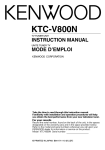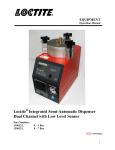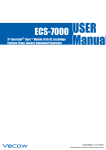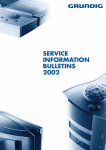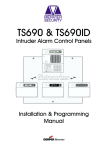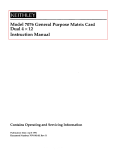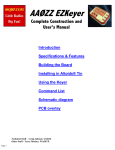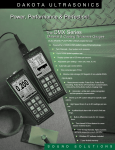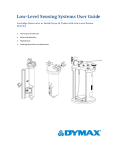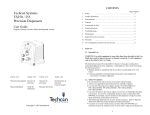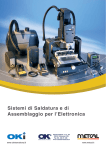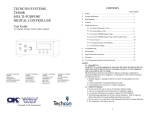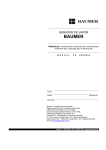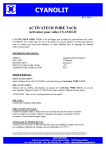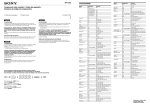Download TS9150 Precision Fluid Dispenser
Transcript
Precision Fluid Dispenser TS9150 USER GUIDE Sales and service www.adhesivedispensers.co.uk [email protected] Tel. +44 (0) 1908 686660 Fax. +44 (0) 1908 686836 The TS9150 fluid dispenser provides many years of trouble-free, productive service. This Operating Guide will help you maximize the usefulness of your new dispenser. Please spend a few minutes to become familiar with the controls and features of your new dispenser. Follow our recommended testing advice. Review the information we have includ- ed based on many years of industrial fluid dispensing experience. Most questions you will have are answered in this guide. However, if you need assistance, please contact us or your authorised ADL distributor. In the UK, call free 0800-094-0958. In the US, call 866.735.4456. Our Promise We pledge that you will be completely satisfied with our range of dispensing products. We strive to ensure that every ADL product is supplied to high quality standards. If you feel that you are not receiving the support you require, or if you have any questions or comments, please email or call us for an immediate response. Our goal is to provide high performance equipment and components, and to build long-term customer relationships based on excellent quality, service, value and trust. Contents Initial Steps One: Unpack and use the checklist enclosed with the Dispenser Kit to identify all items. If there is any discrepancy, please call us immediately. Two: Power and compressed air should be available where the dispenser is to be set up. Air pressure should be between 80 and 100 psi (5.5 and 6.9 bar). If you are not using an ADL five micron filter regulator #TSD800-6, be certain your factory air is properly filtered and dry and a regulated, constant air pressure is supplied to the dispenser. Warning: Bottled nitrogen can be used. If high pressure bottled air or nitrogen is used, a high pressure regulator must be installed on the bottle and set at 100 psi maximum. The TSD800-6 filter regulator is not recommended. Three: ACTIVATE your Two Year Limited Warranty. Please fill in and return the Warranty card. Or if you prefer, call the appropriate number listed below, provide the serial number of your dispenser and respond to a few short questions. In the UK, call free 0800-094-0958. In the US, call 866.735.4456. Connection ..................................... 4-5 Setup for Testing ............................ 6-7 Testing the Dispensers .................... 8-9 Making Timed Deposits of Medium to Thick Fluids Changing Deposit Size and Drawing Stripes Programmable Timer ......................... 9 How to Use the Vacuum Control ... 10-11 Making Timed Deposits of Watery-thin Fluids Component Dispensing System...... 12-13 Loading the Barrel Reservoirs........ 14-15 Schematic & Parts............................ 16 Troubleshooting .............................. 17 Suggestions & Reminders................. 18 Reordering Components .................. 19 Two Year Limited Warranty.............. 20 Meets applicable CE requirements. Foot pedal assembly Air input hose Power cord Mains air, 100 psi max Check voltage label on dispenser Adapter assembly Male quick-connect, insert and twist to lock Sales and service www.adhesive-dispensing.co.uk [email protected] Connection ❶ Connect the air input hose to a plant air source. Set mains air supply within 80 to 100 psi (5.5 to 6.9 bar). Where required, use an ADL five-micron filter regulator #TSD800-6. ❷ Push the air input hose in to the dispenser. Standard 6mm OD hose push fit. ❸ Push in the foot pedal connector, tighten the threaded collar. ❹ Refer to “Making Timed Deposits of Watery-thin Fluids” on page 10 if applicable. ❺ Attach the 10cc barrel (#910-N) to the 10cc adapter head (#71003RHB). ❻ Take the 10cc barrel adapter assembly (#71003RHB on the adapter head) and insert the yellow, male quick-connect into the air output fitting on the front panel and turn clockwise to lock. Place the barrel in the barrel stand. ❼ During this initial testing, you will not use the vacuum control. Keep this control shut off (turned completely clockwise—do not force). Sales and service www.adhesive-dispensing.co.uk [email protected] Controls and Connections Sales and service www.adhesive-dispensing.co.uk [email protected] Setup for Testing Power switch ❶ should be off. The amount of material dispensed each cycle depends on the combination of air pressure, time of air pulse, viscosity of material and dispensing tip size. Note: For watery liquids and Cyanoacrylates, refer to “Making Timed Deposits of Watery-thin Fluids” on page 10. The first step is to remove the tip cap from the pre-filled barrel of blue test material (twist and pull). Replace it with an 18 gauge (green) tapered dispensing tip (#TTN18). Press the tip on and twist clockwise to lock. Pull out air pressure regulator knob ❷ until it “clicks” into the unlocked position. Turn clockwise to adjust the air pressure to 30 psi (2.1 bar) for the initial tests. Always set the pressure desired by turning the air regulator knob ❷ clockwise. To reduce the pressure, turn the knob counter clockwise until the gauge ❸ reads a lower pressure than desired. Then increase and stop at desired pressure. Push knob in to lock. Set time control ❹ to #7. Dispense cycle time increases from 0.01 second minimum to 1.0 second as knob is turned clockwise. Be sure vacuum control ❺ is turned off (turn clockwise) for initial tests. Press power switch ❶ to turn on the dispenser. It will light green. Press timer bypass switch ❻. It will light orange. In this operation mode, the timer will be bypassed to fill the dispensing tip before you begin testing. A continuous flow of material will occur as long as the foot pedal is pressed. Please continue to page 8 for test procedures. Sales and service www.adhesive-dispensing.co.uk [email protected] Making Timed Deposits of Medium to Thick Fluids You are now ready to test the dispenser with a thick, non-levelling fluid such as a sealant, paste or grease. Check your initial settings: A) Air gauge reads 30 psi. B) Timer is set at number 7. C) Green tapered tip is on the test barrel. D) Power and timer bypass switches are on. Holding the barrel as shown, rest the tip on a piece of card or paper. Press the foot pedal until the tip fills and some fluid is pushed out onto the paper. Repeat this whenever you change to a new tip. With the tip filled, turn off the timer bypass switch (orange light out). Take the Dot Test sheet supplied and put the tip on a 1/4" circle, holding the barrel as shown. Press the foot pedal. Check the dot size. Make several more similar dots and note the size consistency. Remember – When the orange timer bypass switch is on, a continuous flow of material will occur as long as the foot pedal is pressed. The orange light must be off to make timed deposits. Note - always bring the tip into contact with the work surface substrate at the shown angle. After the tip is in position, press the foot pedal. Release the pedal and remove the tip by lifting straight up. Sales and service www.adhesive-dispensing.co.uk [email protected] Changing Deposit Size, Making Beads The dot size is determined by the tip diameter, the air pressure output setting and the pulse time. For large dots, use a large tip, higher pressure and more time. Usually, you want to use as short a time pulse as possible. To increase the dot size, slightly increase output air pressure, or increase tip size, or increase both. Dot Test with Green Tapered Tip #TTN18 First, follow the settings illustrated on the right, and you will get dots about the size shown. Try other times and pressures to see how easy it is to get just the dot size you want. Dot Test with Blue Tapered Tip #TTN22 These tests show the effect of using a smaller diameter tip. Replace the green tip with the blue (22 gage) tapered tip. Now, turn on the timer bypass switch and press the foot pedal to fill the tip. Then, turn off the timer bypass switch (yellow light out) and press the foot pedal. To make beads, press the timer bypass switch (yellow light on). With the tip in contact with the test sheet, press and hold down the foot pedal while making a bead or stripe. Programmable Timer Each TS9150 dispenser has a rotary timer with adjustable time ranges. The DIP switch that controls the timer has been set at the factory for a time range of 0.01 to 1.0 second, with the initiation set to MOMENTARY contact. If a longer time range is required, or foot pedal operation needs to be changed from momentary to maintained, choose the appropriate dip switch setting in the chart below. How to Use the Vacuum Control Making Timed Deposits of Watery-thin Fluids The vacuum control allows low viscosity fluids, even water, to be consistently dispensed without dripping between cycles. The vacuum places a negative pressure on the fluid in the barrel and prevents dripping. For these tests, please use water. 1. While holding the barrel upright in one hand, remove the orange end cap ❶ and insert a blue easyflow piston ❷. Push piston down to fluid level from top as shown. 2. Attach the barrel to the 10cc adapter ❸. Snap the safety clip tightly closed to prevent any dripping or bubbling. Remove the tip cap ❹ and attach the 25 gage (red) TE715050PK tip. 3. Set air pressure at 5 psi. 4. Press the timer bypass switch (orange light on). 5. With the barrel pointing downward over a container, unsnap the safety clip. Then press the foot pedal to fill the tip. 6. Set the timer at number 5. Press the timer bypass switch again (orange light out). 7. If a drop begins to form at the end of the tip, slowly turn the vacuum control knob counter clockwise to stop the drop from growing. Wipe the tip and adjust vacuum as necessary. 8. Take the barrel and place the tip on the test sheet. Press the foot pedal and release. Check the dot size. Increase or decrease by adjusting pressure and time. If you choose not to use the piston, please follow these instructions carefully: Some things to remember If you do not use the piston when dispensing thin fluids: 1. While holding the barrel upright in one hand, twist on an orange, black or white tip cap. Using a small funnel, fill about 2/3 full with your fluid. 2. Open the white safety clip and attach the barrel to the 10cc adapter. Do not tip the barrel upside down or lay flat. This will cause the liquid to run into the dispenser. 3. Close the white safety clip as tight as possible. 4. Increase vacuum by gently turning vacuum control knob counter clockwise. When changing tips or attaching a tip cap, snap the safety clip completely closed to prevent any dripping or bubbling. 5. Then, without tipping the barrel upside down, remove the tip cap and attach the 25 gauge (red) #TE725050PK tip. 6. Open the safety clip. Your material may begin to bubble. Reduce vacuum by turning vacuum control knob clockwise. Use an ADL filter trap (#1400-FLT). This filter trap will impede the flow should the low viscosity liquid be sucked back towards the dispenser. 7. If a drop begins to form at the end of the tip, slowly turn the vacuum control knob counter clockwise to stop the drop from growing. Wipe the tip and adjust vacuum as necessary. Now the fluid is in proper balance. It does not bubble or drip. Repeat tests as before, keeping the air pressure low and ad- In the UK, call +44 (0) 1908 686660. In the US, call 866.735.4456 IMPORTANT Regardless of the fluid viscosity, using the correct piston will give you improved results. White PE piston for most fluids, blue Easy Flow piston for watery-thin fluids and red flat wall piston for thick, stringy fluids. See pages 12 13 for a complete description of how our pistons work and the benefits they can bring to your applications. For Thick Fluids If you dispense thick fluids, several problems may occur. First, the repetitive air cycles can bore tunnels through non-levelling fluids, causing spitting and inconsistent deposits. Second, thick fluids contain trapped air that leads to drooling and oozing. These problems are eliminated by using the PE piston. That's because the white pistons pre- vent tunnelling by providing a barrier to the pulsed-air cycles, and prevent oozing by responding to the pressure of trapped air with a slight suck-back movement after the dispense cycle. The white PE piston is used for most fluids. However, if you are applying RTV silicone and find that the piston bounces and causes stringing, switch to the red, flat wall piston. The PE pistons make barrel filling easier, too. As you load the fluid in, air is trapped in the bottom and throughout the fluid. Simply insert a PE piston and gently press down on the fluid as far as possible. This action forces out most of the air and results in consistent deposits. Air Pressure ON Air Pressure OFF No drips or ooze Sales and service www.adhesive-dispensing.co.uk [email protected] For Thinner Fluids If you use low to medium viscosity fluids, the white PE piston has several advantages. First, vacuum adjustment is much less sensitive. Second, the piston prevents fumes from the fluid being exhausted into the work environment. Third, the piston prevents fluid backflow into the dispenser if the barrel is inadvertently turned upside down. Fourth, using the piston makes it easy and safe to change tips without dripping. Note: If you use watery-thin fluids such as solvents, cyanoacrylates and anaerobics, specify the blue Easy Flow pistons. Available in 3cc, 5cc, 10cc and 30/55cc sizes. PE White™ piston prevents fluid backflow Blue Easy-Flow piston for improved control of very low viscosity fluids. Note: The Easy-Flow piston works OK with an air gap between the barrier and fluid. Fumes cannot escape. No air gap when using the White PE™ piston. Note: If you choose not to use a piston, please refer to page 11 for instructions. Sales and service www.adhesive-dispensing.co.uk [email protected] For Cyanoacrylates and Solvents Caution: Do not completely fill barrels. The optimum fill is a maximum 2/3 of the barrel capacity If the fluid you are dispensing is pourable, take the barrel, twist on a tip cap and pour your fluid in. If appropriate, insert the PE piston (see page 13). Carefully press the piston down until it contacts the fluid. The barrel is now ready for use. If you are dispensing solvents, cyanoacrylates or anaerobics, use the Easy-Flow piston. If your fluid is thick or non-levelling, you can spoon it into the barrel with a spatula Or, if the fluid comes packed in a 1/10 gallon cartridge, try loading the barrel with a caulking gun. Then press in the PE piston to move the fluid to the bottom of the barrel and to remove trapped air. Fill procedure for pourable fluids Fill procedure for thick fluids (shown: caulk gun) 2/3 maximum fill 1/2 maximum fill 2/3 maximum fill Easy-Flow Fill procedure for cyanoacrylates or watery-thin fluids 1/2 maximum fill For Thick Fluids We offer productive alternatives to traditional barrel loading methods. Here are a few suggestions that can help keep your work area clean, save time and reduce the chance of entrapped air in the fluid. 1. You could use the ADL #TS900-12- barrel loader. Pack the fluid into the 12 ounce cartridge as shown. Then place the pre-filled cartridge into the barrel loader. Using air pressure, the barrel loader fills the barrel (with piston) from the bottom up. If the fluid comes packed in a 1/10 gallon (310 ml.) caulking type cartridge, use the ADL #900-110 barrel loader. Filling the cartridge for the barrel loader. 2. If you receive frozen epoxies or other fluids in medical type syringes with a manual plunger, ask your fluid packager to use ADL indus- #TSD931-28 Luer-to-luer fitting trial grade barrels, or request our luer-to-luer fitting #TSD931-28 to transfer the material. Please call an ADL Product Specialist for additional application assistance. TS900-12 Barrel Loader 12oz (Specify #9TS900-110 for prefilled 1/10 gallon caulking Barrel Rack #SR03-90W #SR05-60W #SR10-40W #SR30-24W holds (90) 3cc barrels holds (60) 5cc barrels holds (40) 10cc barrels holds (24) 30/55cc barrels 2/3 maximum fill Troubleshooting NO POWER 1. Check voltage at wall outlet. 2. Check fuse. Replace fuse. 3. Unplug from wall, remove top cover, visually inspect for any loose or shorted connections. POWER, BUT NO LIGHT POWER, LIGHT, BUT MACHINE DOES NOT OPERATE INCONSISTENT DOTS Module must be replaced. 1. Unplug power input cord. 2. Check foot pedal connection, foot pedal and internal switch. 1. Check dispensing tip, barrel and material for possible clogging. 2. Check air gauge to be sure air pressure is not varying. 3. Check to see if there are air bubbles in the material being dispensed. MATERIAL SUCK-BACK 1. Use White PE pistons or Easy-Flow Blue to prevent this. (See pages 12-13.) 2. If it occurs, attach an empty barrel, (put timer bypass switch on), put barrel in a cup and press the pedal to expel the suckedback fluid. 3. If problem cannot be corrected, contact an ADL Product Specialist for assistance. Dispensers can be returned to ADL for repair. TIMER SEEMS INOPERATIVE 1. Check to be sure timer bypass switch is off (orange light out). 2. Check DIP switch positions (see page 9). Note: The ADL timer is very reliable. Most questions about the timer are resolved by simply turning the timer bypass switch off (orange light out). ALWAYS SWITCH OFF THE DISPENSER WHEN NOT IN USE TO CONSERVE POWER. Suggestions & Reminders 1. Always use an ADL piston to make your barrel loading, dispensing and handling cleaner, safer and more accurate. Caution: If you dispense watery-thin fluids and choose not to use white PE pistons – do not increase vacuum pressure rapidly and do not tip the barrel. Vacuum may pull liquid into the air hose; or when tipped, liquid may flow back into the dispenser. 2. Always use new barrels and tips. Carefully dispose of after use. This procedure ensures maximum cleanliness, prevents contamination and provides proper safety. 3. Do not completely fill the barrel. For most fluids, optimum fill is a maximum 2/3 of the barrel capacity. For cyanoacrylates or watery-thin fluids, optimum fill is 1/2 of the barrel capacity. 4. Use the ADL syringe barrel racks to help organize bench space for filled barrels. 5. Depending on the type of work you are doing, it may be easier to bring the work to the barrel. Mount the barrel on a stand such as the ADL #7300X. 6. To ensure smooth fluid flow and to make consistent deposits, always have the tip at about a 45° angle to the work surface. Barrel Racks 7300X Stand Sales and service www.adhesive-dispensing.co.uk [email protected] ADL Components Tapered tips gauge 14 16 18 20 22 25 27 standard TTN14 TTN16 TTN18 TTN20 TTN22 TTN25 TTN27E colour Olive Grey Green Pink Blue Red Clear opaque rigid TTN14E TTN16E TTN18E TTN20E TTN22E TTN25E TTN27E colour Salmon Grey Green Pink Blue Red Orange Precision stainless steel tips gauge 14 15 18 20 21 22 23 25 27 30 32 34 0.5” 914050-TE 915050-TE 918050-TE 920050-TE 921050-TE 922050-TE 923050-TE 925050-TE 927050-TE 930050-TE 932050-TE 934025-TE 1.0” 914100-TE 915100-TE 918100-TE 920100-TE 921100-TE 922100-TE 923100-TE n/a n/a n/a n/a n/a 45° 90° 914050-45BTE 915050-45BTE 918050-45BTE 920050-45BTE 921050-45BTE 922050-45BTE 923050-45BTE 925050-45BTE 927050-45BTE 930050-45BTE n/a n/a 914050-90BTE 915050-90BTE 918050-90BTE 920100-90BTE 921050-90BTE 922050-90BTE 923050-90BTE 925050-90BTE 927050-90BTE 930050-90BTE n/a n/a Barrel and Piston Kits 3cc 5cc 10cc 30cc 55cc QTY Clear Barrels White Pistons Clear Barrels Red Pistons Amber Barrels White Pistons Black Barrels White Pistons (50) (50) (50) (50) (50) 903-NW 905-NW 910-NW 930-NW 955-NW 903-NR 905-NR 910-NR 930-NR 955-NR 903-DW 905-DW 910-DW 930-DW 955-DW 903-BW 905-BW 910-BW 930-BW 955-BW Adapter Assemblies 3cc 5cc 10cc 30cc 55cc QTY Black Head 3 ft clear hose Black Head 6ft clear hose (1) (1) (1) (1) (1) 70303RHB 70503RHB 71003RHB 73003RHB 73003RHB 70306RHB 70506RHB 71006RHB 73006RHB 73006RHB Tip Caps & End Caps QTY End Cap 3cc 5cc 10cc 30cc 55cc (50) (50) (50) (50) (50) 903-EC 905-EC 910-EC 930-EC 930-EC QTY Tip Cap All (50) 900-ORTC www.adhesivedispensers.co.uk [email protected] Tel. +44 (0) 1908 686660 Fax. +44 (0) 1908 686836 Warranty ADL Two Year Limited Warranty All specified components of Adhesive Dispensing Ltd (ADL) dispensers are warranted to the original end user for two years from date of purchase. Within the period of this warranty, ADL will repair or replace free of charge any defective component on return of the part, or the complete dispenser, prepaid to the Warehouse. In no event shall any liability or obligation of ADL arising from this warranty exceed the purchase price of the equipment. Before using, user shall determine the suitability of the product for his intended use, and user assumes all risk and liability whatsoever in connection therewith. This warranty is valid only when clean, dry, filtered air is used on the equipment. ADL makes no warranty whatsoever of merchantability or fitness for a particular purpose. In no event shall ADL be liable for incidental or consequential damages. Sales and service of ADL dispensers and dispensing components is available through ADL authorised distributors in other countries. Please contact us for specific names and addresses. Adhesive Dispensing Ltd Unit 501 Milton Keynes Business Centre Foxhunter Drive, Milton Keynes, MK14 6GD, UK Tel. +44 (0) 1908 686660 Fax. +44 (0) 1908 686836 Main Switchboard. +44 (0) 1908 686661 www.adhesive-dispensing.co.uk email: [email protected] ©2014 Adhesive Dispensing Ltd 9150-MAN © Adhesive Dispensing Ltd Adhesive Dispensing Ltd Unit 501 Milton Keynes Business Centre Foxhunter Drive, Milton Keynes, MK14 6GD, UK Tel. +44 (0) 1908 686660 Fax. +44 (0) 1908 686836 Main Switchboard. +44 (0) 1908 686661 www.adhesive-dispensing.co.uk email: [email protected]




















